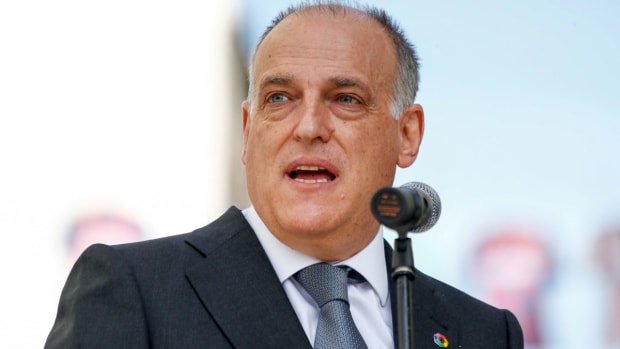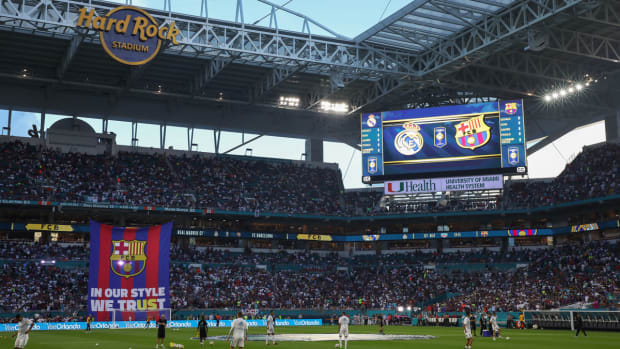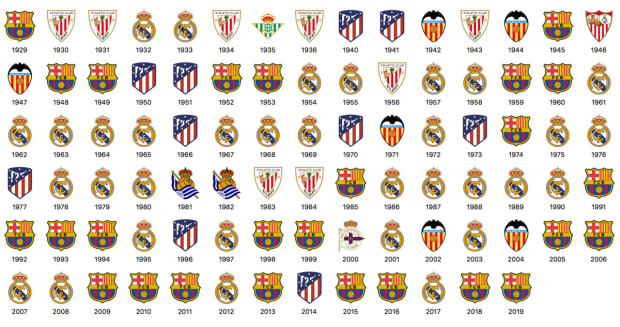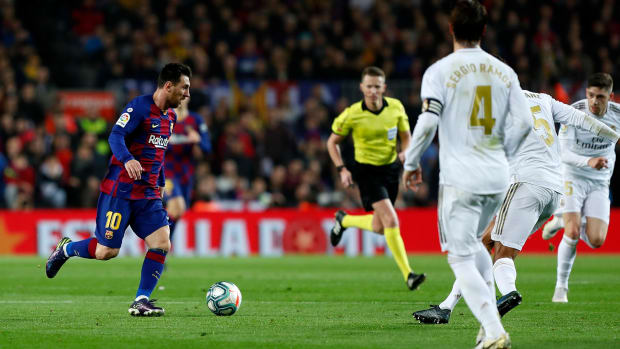Spain's top flight is dying to gain a stronger foothold in North America, but a couple of significant hurdles have impacted its progress.
Soccer has returned to our TV screens, and while the game on the grass remains mostly the same, the surroundings are a reminder of the times. The stands are empty and silent, and different leagues and teams are confronting that atmospheric issue in different ways. Some leave the seats bare. Others use tarps, fans in cardboard form, scarves, mannequins that may or may not be sex dolls or advertising to fill the empty space.
Then there’s La Liga, which took a novel approach. The stands in Spanish stadiums remain deserted in real life, but on TV they’re filled with a computer-generated crowd. The shimmering mosaic of shapes and colors makes it seem that from a distance, the place is packed. With a few keyboard strokes, La Liga generated an impression of passion where there’d been a void.
It’s a modern solution to a modern challenge, as well as a symbolic sign that La Liga, despite its success on the field, is willing to try something new to build an audience. Outside Spain, the audience it covets more than any other is in the USA. There, La Liga has another modern challenge. And, it hopes, a modern solution.
“For us, the USA is, after Spain, the most important country that we need to actually activate,” La Liga president Javier Tebas told Sports Illustrated. “The league has to make an effort to attract American viewers and supporters. We need to find those supporters.”
Tebas referenced the population, the maturity of the TV and sports marketing industries and the country’s “purchasing power”—all of it still a relatively untapped resource for a highly regarded league that’s been in business since 1929.

“It’s a constant job we need to do. It’s not enough to play some games in the USA. You need to do many other things. You need to have a digital strategy, audiovisual distribution, many other things,” Tebas said. “And we are working on that, actively. You always need to better yourself, because you better yourself or you die.”
The playing field is now world-wide. At the highest level, pro soccer has transformed from a parochial, community-oriented activity to something resembling a global arms race, where viewers and dollars—especially in Asia and the Americas—are increasingly important as player salaries and competitive stakes rise. To be bigger, leagues have to look beyond their borders.
La Liga has done so broadly, with the placement of individual employees they call “delegates” in 43 countries around the world. And it’s done so more narrowly, with the opening of 11 international offices, including one in Mexico City. Then there’s the USA, which is getting a level of attention and investment that’s unique in international soccer.
The process began in the summer of 2017, when Barcelona and Real Madrid—the rivals who are in some ways La Liga’s greatest asset and in others a significant liability—played a friendly outside Miami. The International Champions Cup game at Hard Rock Stadium drew more than 66,000 fans and generated some $38 million in direct revenue. That led to a conversation between La Liga and Relevent, the ICC organizer controlled by Dolphins owner Stephen Ross.

“Relevent pitched La Liga and said, ‘You can’t expect to come to the U.S. every four years to try to renegotiate your TV rights and see an uptick in the value of those rights if you’re not working to develop the market—doing stuff day-in and day-out to help grow the value of the brand,’” Boris Gartner said.
Gartner, a former Televisa and Univision executive from Colombia, now runs the result of those conversations. Two years ago, La Liga and Relevent formed La Liga North America. It’s a 15-year, 50/50 joint venture designed to generate marketing and sponsorship opportunities in the USA and Canada and to, as Gartner said, do the day-to-day work that’ll build La Liga’s brand equity. Relevent has invested close to $10 million so far, Gartner confirmed.
“You ask any international football executive, and they all pretend to have or want to have a U.S. strategy,” he said. “But very few of them are willing to commit the money and resources to actually do that.”
Why the investment? Why the effort? Because even if La Liga is No. 1 on the field—it leads UEFA’s coefficient ranking by a healthy margin, although the Premier League has gained ground over the past three seasons—it’s far from No. 1 in Tebas’s No. 2 market.
Liga MX’s popularity is buttressed by the nearly 40 million U.S. residents who identify as Mexican or Mexican-American. The EPL is the sport’s most glamorous domestic circuit. It features a relatively significant amount of top-to-bottom competitiveness and its clubs, especially those beyond the title contenders, are well-branded and recognizable. It’s also benefited from its NBC platform since 2013. And then there’s the Bundesliga, whose games were on Fox for five years and whose clubs field more Americans abroad than any other major league (not to mention the best Canadian prospect ever).
“We’ve been at this almost two years—not even two years,” Gartner said. “The Premier League, as a presence in this country, they’ve been at it for much, much longer. We need to catch up. I think even as we accelerate our growth, there’s a ton more that needs to be done.”
From a distance, La Liga faces two significant obstacles—one of which isn’t entirely of its own making. There’s a reason the excitement and publicity that surrounded sports’ return from the pandemic pause fell more generously on the Premier League and Bundesliga: the decline of La Liga’s American TV partner, BeIN Sports. The Qatari company broadcasts Spanish matches in 17 territories around the world, Gartner said, but it’s U.S. audience plunged two years ago when BeIN was dropped by both Comcast and DirecTV. The network fell from around 75 million subscribers during the 2017-18 season (English and Spanish language combined) to 27 million.
And after BeIN triggered a renewal last year, La Liga now is tied to the network for four more seasons, until 2024.
“It means we have narrower reach, so we have been developing other strategies,” Tebas said. “I think a balance needs to be struck between what you get paid and the exposure you have.”
Gartner has no choice but to look for silver linings. One is that the money is decent. He said BeIN pays La Liga “just under” the $167 million per season the Premier League nets from NBC. Another is that the league feels valued.
“When you are the core property for a network, they’re going to give you disproportionate amounts of attention and promotion and everything that comes with it,” Gartner said. “The other thing is understanding where some of the competing leagues are in the landscape, and you see Serie A is on [ESPN] Plus. The Bundesliga was buried on Fox somewhere and now it’s going to [ESPN] Plus. The Champions League had a big window on Univision but is buried on B/R Live. The fact that we had an outlet with English and Spanish, with a linear presence and that we were going to be the core property for it … you have to build a balance with that scale and the value of your rights.”
He continued, “Everything we do is governed by what clubs want or need. You sit down with clubs and you ask them, ‘What do you want, more distribution or more revenue?’ They’ll all tell you that philosophically they want more distribution, they’re in this for the long run, get their property in front of as many people as possible. Well that means the revenue you’re receiving is 20% less. Then they’ll say, ‘Actually hold on ….’”
That makes sense, because in La Liga every cent matters. It matters because the league is ruled by the two wealthiest clubs in the sport. That’s the second obstacle. Barcelona and Real Madrid attract the the interest and fascination of the world. They play in La Liga, but they’re bigger than La Liga. Their domestic dominance makes many games, besides the ones against each other, almost moot. And the shadow cast by El Clásico renders so many smaller clubs in Spain, like the Osasunas and Levantes, almost anonymous beyond its borders.

Barcelona and Madrid have combined to win 14 of the past 15 La Liga titles, and it’ll be 15 of 16 by the end of this month. And even though the Bundesliga, Serie A and Ligue 1 are each currently ruled by one club, that hasn’t historically been the case. Teams in those countries have had the chance to build up their trophy cases, and thus a bit of renown. Only five Spanish clubs have won at least three top-tier championships. Compare that to England (14), Germany (12), Italy (eight), France (14) and Mexico (12).
The recent Europa League success of Sevilla (five titles) and Atlético Madrid (three) speaks to La Liga’s quality. But the fact that those two clubs have combined to beat out both Barça and Madrid just once in that 15-year span demonstrates how high the hurdle is.
Tebas, Gartner and their colleagues want to grow La Liga, and to do so, they’ll have to get American fans to become more familiar with the other 18 clubs. Where’s Real Sociedad from? Who’s the best player on Leganés? What are Valladolid’s colors? Those questions and identities matter when you’re trying to build interest in an inclusive, season-long narrative.
“The history of Spanish soccer has been built on the pillars of Real Madrid and Barcelona, and that is a reality we can’t deny. But even with that reality, La Liga, together with the Premier League, is one of the biggest leagues in the world,” Tebas said. "What we need is for other clubs to grow in the same way. We don’t want to do anything artificial. We want things to be as natural as possible so other clubs might appear, such as Atlético and Sevilla. They are also winning titles and eventually, they’ll be as competitive as Madrid or Barcelona.”

Tebas took a massive step toward helping Atleti, Sevilla and the rest of the league compete back in 2015, when TV rights were centralized for the first time. Previously, each club marketed its broadcast rights separately, which left almost nothing for mid-size and smaller clubs. According to La Liga, the TV revenue gap between the biggest and smallest teams used to be 12:1. Following the 2018-19 season, it had dropped to 3.5:1.
Money earned through participation and success in continental competition still isn’t shared, which skews the ratios further in favor of Madrid, Barcelona and to a lesser degree the likes of Atleti or Valencia. But it’s not as bad as it was. It’s a start.
Meanwhile, the La Liga North America will try to balance the appeal of its most valuable asset with the need to make the competition about more than just El Clásico.
“It would be crazy for us, as a league in the U.S. trying to grow the brand and the value to not leverage the existing, overwhelming dominance and fandom that Real Madrid and Barcelona have,” Gartner said. “It would be equally crazy and equally stupid not to use the platform that we have and the access that we have, driven by those two teams and arguably Atlético as well, to promote and push the other 17-18 teams.”
Augmenting BeIN’s production with its own digital content is a massive part of the joint venture’s strategy. It produces 12 weekly shows—six in Spanish and six in English—geared toward American audiences. Former U.S. international Jimmy Conrad is among its presenters. Overall, video views on social media and YouTube have increased nearly four-fold to more than 7 million this season.
“We try to tell many stories about the clubs, sentimental stories and stories out of the ordinary not strictly related to sports,” Tebas said.
“We can build a content piece around Messi and it would have millions of views, because at the end of the day, it’s Messi. It requires a bit more research and knowledge of the competition and your audience, but you can achieve this same scale and views with 10 smaller stories that probably will have deeper engagement,” he said. “If I tell a [Real] Betis story with Andrés Guardado and Diego Lainez, yes, it’ll be a fraction of a Messi story, but the engagement it’ll drive from U.S. Hispanics with Mexican descent is crazy.”

Gartner said he’s a big believer in demographics as destiny. La Liga North America is a “long-term play.” The growing Hispanic population in the U.S., which includes a lot of first- and second-generation natives with a cultural predisposition to soccer, is the primary initial target for the joint venture’s initiatives.
“The country is getting more brown and more young and more diverse, and these people are already bought into soccer,” he said. “If you’re trying to get the full picture of the country, all demos, [soccer] might [rank] fourth. But what’s the growing demo, and where’s that growth coming from? A young, diverse, multicultural audience that favors soccer.”
In addition to content and sponsorship (its announced three partners so far, with two more coming), La Liga North America has gotten involved with youth soccer, launching academy and camp programs in Miami and Toronto and partnering with U.S. Club Soccer. At a higher level, its La Liga ProPlayer program creates a pathway for older Spanish academy players to move to the USA, attend college, earn a scholarship and play soccer. Twenty-six players from 21 first- or second-division La Liga teams took advantage in 2019, bringing the gospel of Spanish soccer with them. For fans, its working with bars and restaurants in different cities to create “permanent homes” for La Liga broadcasts.
The joint venture's holy grail, however, is the game itself. It’s as novel an idea as the virtual fans—play an official league match on American soil. On the pyramid of pillars underpinning La Liga North America, staging a game (or several) in the USA is at the top. It's unprecedented, and it's controversial. The first attempt, a Girona-Barcelona meeting in Miami in January 2019, was abandoned when the parties ran out of time to secure approval. The Spanish federation (RFEF), U.S. Soccer Federation, UEFA and Concacaf all had to sign off.
“We still strongly believe that having an official league match is the right step in the evolution of the growth of international soccer in the U.S., but also La Liga. If you follow the international strategy of all the American leagues, it was clearly along the same lines,” Gartner said, referring to the NFL, NHL, NBA and MLB all playing regular-season games abroad.
Not everyone feels that way. FIFA president Gianni Infantino lacks jurisdiction, but didn’t seem thrilled with the idea in 2018, when he told Sports Illustrated, “I think I would prefer much more a great MLS game in the U.S. rather than La Liga being in the U.S.” The RFEF and USSF, which partners with MLS through Soccer United Marketing, are even less enthused. Both want to protect their turf. La Liga sued the RFEF in Spain in late 2018, and Relevent filed a federal antitrust case against U.S. Soccer in April 2019 that’s still in its early stages.
It may be a while before La Liga can stage its game here, if ever. But both sides of the joint venture are willing to put in the time. Again, this was a 15-year agreement. The BeIN deal runs another four seasons, and the 2026 World Cup is just beyond that as another tantalizing catalyst.
“You have highly motivated parties in Relevent, Stephen Ross, Tebas and La Liga, to try and pull that off,” Gartner said. “Just from a U.S. perspective, to feel the growth of the league here, there would be no bigger stunt than this. It you think about the growth of the value of international football—not just La Liga and not just the two teams that come—it’ll help grow the value of the TV rights even more, the commercial value, and that revenue gets distributed to all 42 teams [in the Spanish first and second divisions]. It will fuel the growth of the other teams.”